For all info on the latest updates from the Volunteer FlightModel Team, please visit: http://bhlanding.ient.com/warbirdsforum ... um.php?f=8
You can also find all our updates compiled at: http://bhlanding.ient.com/warbirdsforum ... um.php?f=5This update is now live!---== UPDATE FL2057: FORK-TAILED DEVILS ==---By: Robert, Bollok and Grumpy
All made possible by: Bcamel (creator of the program used to model the airplanes), and Idunno (who has previously shared a vast amount of aerodynamical knowledge).
--= P-38 Lightning series =--The whole P-38 series has been fully remodeled. See further below for details.
--= Spitfire series =--* All Spitfires have had their pitch authority at high speeds slightly lowered to reduce the risk of overstressing the airframe due to the G's spiking.
* Slight PitchDiv raise to all Spitfires in order to decrease the nose bounce when pulling G's.
* The Spitfire Vb now suffers from neg G cutout like the Spit I & II. The "Miss Shilling's Orifice" wasn't standard carburetor equipment until the Vc model.
* The Spitfire IXa didn't have the Bendix-Stromberg carburetor, and as such now has the same neg G behaviour as the Spit LF Vc. (the "Miss Shillings Orifice" installment)
* Both Seafires now have the tail hook enabled.
--= N1K1-J =--* Now has a featherable propeller (this is done automatically when the engine is turned off). This improves it's gliding distance with a dead engine due to reduced propeller drag.
* Flaps dragco increased somewhat.
--= P-51 series =--* Slight PitchDiv raise to the A-36 Apache, Mustang Mk 1, P-51B and P-51D in order to decrease the nose bounce when pulling G's.
--== THE NEW P-38 LIGHTNINGS ==--The P-38's fought against the Axis airforces in several theaters during ww2. The Lightning really shined in the Pacific with boom n zoom tactics against the slower Japanese fighters, but even in Africa/Europe the P-38 had a positive kill-to-loss ratio. The Germans nicknamed it "Der Gabelschwanz Teufel" (The Fork-Tailed Devil). While being active in the Pacific to the end of ww2, in Europe it was phased out by Jimmy Dolittle in second half of 1944, in favour of the P-51 Mustang. The reason was mainly the fact that the Lightning had problems with a high rate of engine failures, it cost over twice the money to produce compared to a P-51 and had bad cockpit heating that was better suited for the warmer Pacific theater. The P-51 also had a longer fuel range and was faster.
Some of the P-38's weaknesses, that J. Dolittle also was concerned about, is that the Lightning has a quite slow roll rate and compresses in a high speed dive due to it's aerodynamics disturbing the airflow around Mach 0.67. On the bright side the P-38 has good firepower and ammo capacity though with 4x .50 cals and 1x 20 mm cannon. These are all located in the nose so convergence isn't a problem. The two engine propellers are counter rotating and as such this fighter doesn't suffer from torque like single engine fighters do. The Lightnings also have a nice selection of ordnance and are potent in ground attack roles. A common misconseption about the Lightnings is about them being "unagile" fighters. Many people and also flightsimulators have this wrong as if the P-38 should be turning like a truck. It definitely shouldn't. The P-38 not being agile has to do with it's poor roll rate and weight, making it unsuitable for low n' slow maneuver combat like going into scissors. When it comes to turn fighting though this twin engine fighter has a good power/weight ratio and a large wing area with a 16% root thickness ratio. The long wing span also helps with induced drag and when using the combat setting at 8° for it's Fowler flaps, this bird can hold a turn quite well. It's not like a Spitfire or A6M Zero, but can definitely hold it's own against many opponents. The P-38's best envelope is as a high altitude interceptor, and as such a P-38 pilot would generally benefit from doing bomber escort or in other ways taking the fight up high. While being able to fight down low, at high altitude is where the "Fork-Tailed Devil" shines and can take it all the way up to 39000 ft.
--= P-38F =--The P-38F is powered by the Allison V-1710-49/53 engines, producing 1225 hp each. For it's era this is the fastest American fighter above 15000 ft, and also the best climber. The turn rate is comparable to that of a C.205 Veltro or F6F-5 Hellcat. The firepower is good and it's a great fighter for boom n zooming while also able to turn a few laps with the bandit. Avoid low n' slow maneuver fights though as the roll rate is poor and it's a heavy bird. A wise Lightning pilot fights the enemies between 20000-39000 ft.
--= P-38G =--The P-38G is very similar to the P-38F but 120 lb lighter and can run at 41" of manifold pressure for a longer time with it's V-1710-51/55 engines. It has the same max power of 1225 hp though. An important difference is that the P-38G can use an 8° combat flaps setting which improves the Lightning's turn rate quite a bit.
--= P-38J =--The J-version had notably improved engines, the Allison V-1710-89/91, capable of producing 1570 hp. It has a slightly higher drag but is 10-13 mph faster than it's predecessors. Also the climb rate is improved due to it's better power/weight ratio. The weight is around 833 lb heavier than the P-38G though and while being able to turn well, it holds a somewhat larger turning radius. The P-38J can use rockets for attacking ground targets which is a nice addition. The service ceiling is around 40000 ft.
--= P-38L =--While being the heaviest of the Lightnings, weighing in at 18055 lb, the P-38L has several improvements. The most significant one is the power boosted ailerons. This gives the P-38L a much needed increase to the roll rate at high speeds, and also a slight improvement at lower speeds. The code does not allow for modelling the historical special designed dive recovery flaps of the P-38L, but the flightmodel is instead able to dive 20 mph faster before compression occurs. The L-version's V-1710-111/113 engines are very similar to the P-38J engines and also able to produce 1570 hp. The ordnance is even more enhanced with the P-38L able to carry 2x 2000 lb bombs, making it very effective for jabo missions.
Below is data from my recent tests of the new flightmodels:
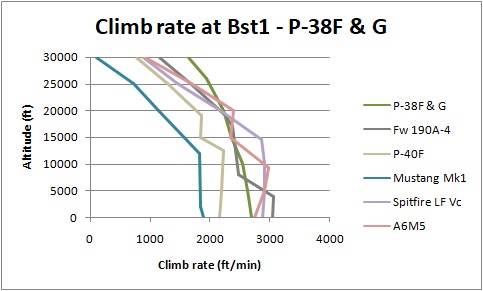
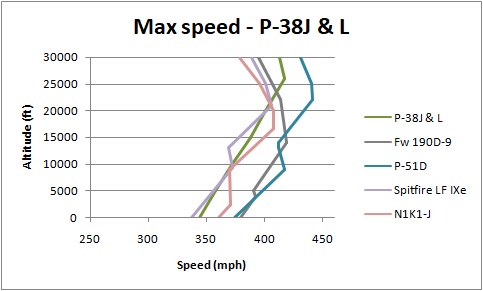
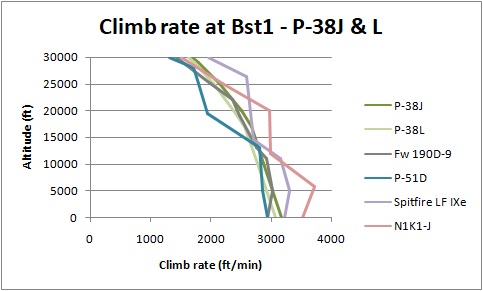
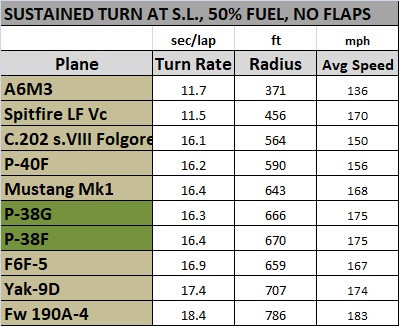

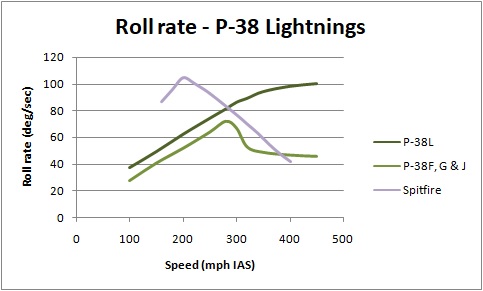 free image hosting
free image hosting<S>
/Robert






